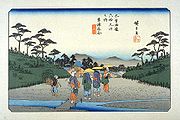
Kusatsu-juku
Encyclopedia


53 Stations of the Tokaido
The are the rest areas along the Tōkaidō, which was a coastal route that ran from Nihonbashi in Edo to Sanjō Ōhashi in Kyoto.-Stations of the Tōkaidō:...
of the Tōkaidō
Tokaido (road)
The ' was the most important of the Five Routes of the Edo period, connecting Edo to Kyoto in Japan. Unlike the inland and less heavily travelled Nakasendō, the Tōkaidō travelled along the sea coast of eastern Honshū, hence the route's name....
as well as the sixty-eighth of the sixty-nine stations
69 Stations of the Nakasendo
The are the rest areas along the Nakasendō, which ran from Nihonbashi in Edo to Sanjō Ōhashi in Kyoto. The route stretched approximately and was an alternate trade route to the Tōkaidō.-Stations of the Nakasendō:...
of the Nakasendō
Nakasendo
The , also called the , was one of the five routes of the Edo period, and one of the two that connected Edo to Kyoto in Japan. There were 69 stations between Edo and Kyoto, crossing through Musashi, Kōzuke, Shinano, Mino and Ōmi provinces...
. It is located in the downtown area of the present-day city of Kusatsu
Kusatsu, Shiga
is a city located in Shiga Prefecture, Japan. The city was founded on October 15, 1954, and as of 2008, the city has an estimated population of 123,690 and the density of 1,820 persons per km². The total area is 67.92 km².- Overview :...
, Shiga Prefecture
Shiga Prefecture
is a prefecture of Japan, which forms part of the Kansai region on Honshu Island. The capital is the city of Ōtsu.- History :Shiga was known as Ōmi Province or Gōshū before the prefectural system was established...
, Japan
Japan
Japan is an island nation in East Asia. Located in the Pacific Ocean, it lies to the east of the Sea of Japan, China, North Korea, South Korea and Russia, stretching from the Sea of Okhotsk in the north to the East China Sea and Taiwan in the south...
.
History
Coming from Moriyama-jukuMoriyama-juku
was the sixty-seventh of the sixty-nine stations of the Nakasendō. It is located in the present-day city of Moriyama, Shiga Prefecture, Japan.-History:...
, the borders of Kusatsu-juku started at the banks of the Kusatsu River to the present-day Miya-chō in Kusatsu. The famed ukiyo-e
Ukiyo-e
' is a genre of Japanese woodblock prints and paintings produced between the 17th and the 20th centuries, featuring motifs of landscapes, tales from history, the theatre, and pleasure quarters...
artist Hiroshige
Hiroshige
was a Japanese ukiyo-e artist, and one of the last great artists in that tradition. He was also referred to as Andō Hiroshige and by the art name of Ichiyūsai Hiroshige ....
traveled through the post station
Shukuba
were post stations during the Edo period in Japan, generally located on one of the Edo Five Routes or one of its sub-routes. They were also called shukueki . These post stations were places where travelers could rest on their journey around the nation...
using both the Tōkaidō and the Nakasendō in order to create woodblock prints.
In 1843, the post station had 2,351 residents and 586 buildings. Among the buildings, there were two honjin
Honjin
thumb|250px|The honjin at [[Inaba Kaidō]]'s [[Ōhara-shuku]]. is the Japanese word for an inn for government officials, generally located in post stations during the later part of the Edo period.-Evolution of Honjin:...
, two sub-honjin, and 72 hatago
Hatago
were Edo period lodgings for travelers at shukuba along the national highways, including the Edo Five Routes and the subroutes. In addition to a place to rest, hatago also offered meals and other foods to the travelers...
. Of the two honjin, one was constructed in 1635 and stood until 1870. That honjin was later repaired and opened as a museum in 1996.
Neighboring post towns
Nakasendō- Moriyama-jukuMoriyama-jukuwas the sixty-seventh of the sixty-nine stations of the Nakasendō. It is located in the present-day city of Moriyama, Shiga Prefecture, Japan.-History:...
- Kusatsu-juku - Ōtsu-jukuOtsu-jukuwas the last of the sixty-nine stations of the Nakasendō, as well as the last of the fifty-three stations of the Tōkaidō. It was from the previous post town, Kusatsu-juku, and was located in Ōmi Province...
Tōkaidō
- Ishibe-jukuIshibe-jukuwas the fifty-first of the fifty-three stations of the Tōkaidō. It is located in the downtown area of the present-day city of Konan, Shiga Prefecture, Japan...
- Kusatsu-juku - Ōtsu-jukuOtsu-jukuwas the last of the sixty-nine stations of the Nakasendō, as well as the last of the fifty-three stations of the Tōkaidō. It was from the previous post town, Kusatsu-juku, and was located in Ōmi Province...

